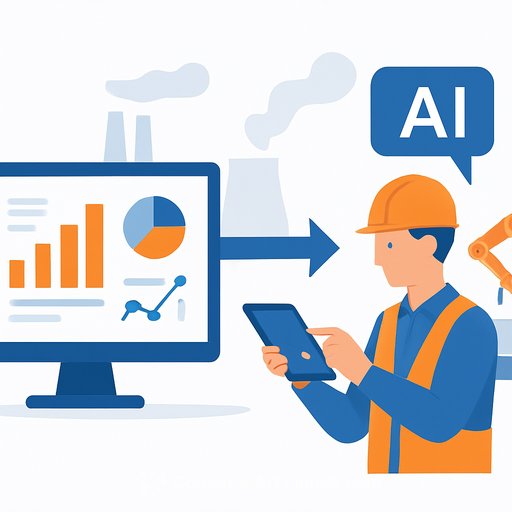AI in HVAC: Transforming Energy Efficiency and System Performance
AI is changing how Operations teams run HVAC. With smarter control, live analytics, and predictive maintenance, you cut energy use, prevent downtime, and keep comfort consistent. The result: lower OPEX, fewer surprises, and clearer decisions.
Commercial HVAC drives a large share of building energy consumption. AI lets systems adapt to occupancy, weather, and usage patterns in real time, optimizing performance across complex portfolios without constant manual tweaks.
What Changes for Operations
Traditional HVAC relies on fixed setpoints and scheduled maintenance. AI flips that model. Algorithms read sensor data, learn how equipment behaves under different loads, then adjust continuously to meet targets for comfort and efficiency.
Modern maintenance platforms integrate these insights into daily workflows-streamlining inspections, routing alerts, and feeding your CMMS/BMS with actionable data instead of raw noise.
Energy Efficiency That Shows Up on the Bill
AI reduces waste by matching run-time to actual need. Think AC that doesn't cool empty floors at night, or variable ventilation that scales with occupancy and humidity. Across mixed-use sites, AI balances ventilation, temperature, and even lighting schedules to hit comfort and energy goals together.
For a broader view of HVAC efficiency practices, see the U.S. Department of Energy's guidance on efficient heating and cooling. DOE resource
Predictive Maintenance and System Health
Scheduled servicing misses early warning signs. AI spots anomalies in vibration, temperature, pressure, current draw, and airflow-flagging issues before they escalate. This reduces unplanned downtime, parts spend, and overtime callouts.
Teams move from firefighting to planned interventions. Assets last longer, performance stays stable, and service windows become shorter and safer.
Air Quality and Comfort You Can Defend
Comfort and IAQ standards are non-negotiable. AI monitors CO2, humidity, temperature, and ventilation continuously, adjusting outside air and supply to maintain healthy conditions across schools, hospitals, offices, and public spaces.
In data centers, models fine-tune airflow and temperature bands to protect hardware while trimming kWh used for cooling.
Case Studies and Results You Can Expect
- BrainBox AI: Uses deep learning and live building data to optimize HVAC control in large facilities, reporting meaningful energy reductions across portfolios.
- Commercial buildings: Many report 20-30% efficiency improvements using models that account for occupancy, weather, and airflow.
- Data centers: AI improves airflow management and temperature control, cutting cooling energy while keeping strict thermal limits.
Generative AI: From Tuning to Self-Optimization
Generative AI can simulate building behavior, forecast energy use, and propose control strategies for complex sites. Combined with predictive maintenance, you get systems that learn continuously, adapt to real conditions, and run with minimal manual input.
Known Challenges (and How to Manage Them)
- System complexity: Many components and control layers. Start with high-impact zones (e.g., air handlers, chillers) before scaling.
- Upfront cost: Pilot on a subset of assets to prove savings and build the capital case.
- Data needs: Quality sensor data matters. Validate calibration, logging intervals, and data retention.
- Integration: Align with your BAS/CMMS and security policies. Use APIs and open protocols where possible.
Monitoring and Control That Improves Decision-Making
AI turns sensor data into clear control actions and reports. Operations managers get dashboards that explain what changed, why it changed, and how much energy and cost were saved. This supports compliance, audits, and budgeting with evidence-not guesswork.
Implementation Playbook for Operations
- 1) Baseline and goals: Map assets, zones, and schedules. Set targets for energy, comfort, and uptime.
- 2) Data readiness: Verify sensor coverage (CO2, temp, humidity, pressure, flow, amperage). Fix gaps and calibrate.
- 3) Integrations: Connect BAS/BMS, meters, and CMMS. Define who receives which alerts and in what format.
- 4) Quick wins: Start with after-hours setbacks, occupancy-based ventilation, and chiller/boiler sequencing.
- 5) Pilot and iterate: Run a 60-90 day pilot on one building or floor. Compare against baseline. Expand after proven ROI.
- 6) SOPs and training: Update playbooks for alerts, overrides, and escalation. Train techs on reading model outputs.
- 7) Review cadence: Monthly reviews on KPIs, savings, and comfort metrics. Tune models as seasons change.
- 8) Security and compliance: Enforce least-privilege access, audit logs, and network segmentation for OT systems.
Metrics That Keep Everyone Aligned
- Energy: kWh/m² (or ft²), peak demand, chiller/boiler efficiency, ventilation runtime, EUI by building.
- Reliability: Mean time between failures, anomaly detection lead time, false-positive rate, work orders avoided.
- Comfort & IAQ: Hours in range for temp/humidity, CO2 thresholds, complaint rate per 1,000 m².
- Financial: OPEX reduction, payback period, cost per avoided outage, risk-adjusted ROI.
Practical Alert Examples
- CO2 above target for 15 minutes while supply air remains constant.
- Fan VFD at 95-100% for 30 minutes indicating filter or duct restriction.
- Chiller approach temperature drift signaling heat-exchanger fouling.
- Compressor short-cycling beyond threshold suggesting control or refrigerant issues.
What This Means for Your Team
Fewer breakdowns, clear KPIs, and systems that adapt without daily micromanagement. Your team spends more time on optimizations and less on reacting to alarms. Tenants stay comfortable. Energy costs drop. Leadership sees measurable progress on sustainability.
Next Step
If your team is building AI capability in Operations, structured learning paths can speed adoption and help standardize best practices. Explore AI upskilling paths for operations teams to close skill gaps and support your rollout.
AI in HVAC is a practical upgrade for performance, cost control, and occupant health. With the right data, integrations, and playbooks, your buildings can run cleaner, smarter, and more reliably-day in, day out.
Your membership also unlocks:






